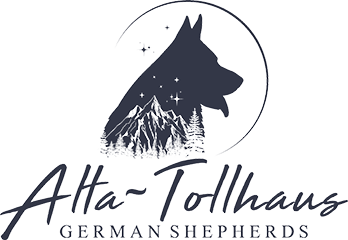Happy New Year and Hello A-T Family!!! Just looking up some information regarding the new diet Rudi LOVES and sure enough it’s on the hit list. The rabbit comes from China. He loves this food and my question is, are the other varieties they offer coming from China too? We’ve only tried the rabbit, but now I’m concerned. Any comments will be appreciated. Oh, I should say we feed him a mixture of Royal Canin GSD and the Instinct Rabbit kibble with about 1/4 of the canned rabbit. I know this sounds rediculous but he is more interested in playing, SAR and guarding the backyard than eating. Thank you in advance!
Julie H


Not sure where you live, but if you want rabbit you could try;
http://rawdogplus.com/prices.html
I personally would not feed any food sourced from China
Hi Julie H
Happy New Year to you too! I agree with Lisa, too much history of problems with food coming from China. I am hoping Karen Murray will speak up on this one for you.
Julie
Lisa and Julie, thank you so much. Yes, we will make a change and keep the GSD Royal Canin, of course. Geeze, I’m beginning to think “Pets or Meat”. Please no negative comments! Rudi loves bunnies, real or play. Me, I’m not killing bunnies!
Hi There!
Their rabbit IS sourced from China.
Wouldn’t ya think they’d be able to get it in the US since rabbits are so easy to breed???? LOL
Nature’s Variety assures their customers: “In the case of rabbit meat, we’ve found that the best supply of high quality, human grade rabbit is found in China. Therefore, we are currently sourcing rabbit meat specifically for our raw and canned rabbit diets from a trusted supplier in China. To help ensure that our strict quality and safety standards are rigorously enforced, this rabbit meat is regularly inspected and monitored by the PhD food scientist we have on staff. Additionally, members of the Nature’s Variety leadership team have personally visited and inspected the facility in China”.
Personally, I do not buy any meat or fish from China. Ya jess never know! But, Nature’s Variety is much more contentious than most of the pet food companies so their other products would be great in comparison. The rest of NV ingredients, including vitamins and minerals, do NOT come from China, and they are GMO FREE.
BTW, Royal Canin sources their vitamins/minerals “internationally” which could mean China, and, so far, appears that they DO source GMO ingredients. Some of their canned foods contain “by products”.
The only other thing I would say about NV is that they use Sodium Selenite and Copper Sulfate but you’d be hard pressed to find another company that doesn’t use it except for Acana, Orijen and The Honest Kitchen.
Hope this helps! 🙂
Does NV source Vitamin C from the United States? I stopped ordering their canned food because of the rabbit sourcing issue – we stick solely to Wellness at this time. Wellness does source Vitamin C from China and I don’t love that it shares “plant space” with less high quality food….but we kind of have to use what works.
Hey Jamie! How’s that beautiful girl of yours? Have you been competing?
I understand about the canned food with Pieka but you are doing everything you can do considering her condition.
So here’s the skinny…sorry…..it’s long answer: “China is by far the largest importer of Pet Food Ingredients to the U.S. according to PetfoodIndustry.com. They state that in just the month of February 2011, 70 percent of pet food ingredients imported to U.S. pet food manufacturers came from China. In that month alone, almost $22 million dollars worth of pet food products were purchased from China.” Check out the vitamin supplier’s on this site but note that companies from over-seas group cold blooded and warm blooded animals together for their multi-vitamins. Of the 38 shown on this one page, 34 were from China:
http://www.alibaba.com/trade/search?fsb=y&IndexArea=product_en&CatId=SearchText=animal+vitamin+feed+premix
Federal law requires food companies to be able to trace products one step backwards, so if a manufacturer purchases from a 3rd party and only checks backwards one step, they may “assume” they are purchasing from a US company but that US company may have purchased those products from overseas! So can the purchasing company claim the ingredient it is from the USA????? Hmmmmm…..
Dr. Mercola Comments: “Almost all vitamin C sold in the United States is from China. They also produce 50 percent of the world’s aspirin and 35 percent of all Tylenol. Since the United States does not require country-of-origin labels for any of our drugs, foods or supplements, there is no telling where that vitamin you are taking came from.”
I’m like everybody else and take commercially prepared vitamins, but the next time you go shopping to buy vitamin products, look to see if the labeling actually tells “where” the ingredients were sourced from. Instead, you’ll see things like “Marketed by” “Distributed by” and/or better yet, my favorites, “HOLISTIC” or “NATURAL” (Buzz Words) with a US address. But, a huge percentage of vitamins, including 80% to 90% of vitamin C (ascorbic acid) being sold in the US, is now imported from…..guess who????….Yup!….CHINA! We blindly assume that the law requires all of our products sold in the U.S.to list where they are made but, turns out that that rule does not apply to over-the-counter medications which include vitamins and even aspirin!
When imported, does our regulatory system thoroughly test these vitamins for safety? What about testing “ANIMAL VITAMINS”? What about the things they DON’T test for???? This is how the pet poising of 2007 happened.
What about the claim “Made In The USA”????
According to Dr. Becker, the U.S. country of origin labeling laws only requires that products made in the U.S. be put together here. There’s no requirement of pet food manufacturers to identify where the ingredients in their products come from.”
opurity.com states that people might think that companies make their own products, or that at least they say they are made in the US. All too often that is no longer true. Eight million shipping containers arrive at the Port of Los Angeles alone, most of them from China. They further state that while Chinese manufacturers don’t always place a high priority on quality, they clearly understand the value of making their American buyers dependent on them. Sometimes the American company gets so dependent on the Chinese companies, that make their products, that the American company is afraid to complain too much about quality problems! In “Poorly Made in China,” Paul Midler notes that “Chinese manufacturers had caused Mattel great reputation damage by delivering toys that were contaminated with lead paint.” Yet following a major recall by Mattel, Mattel executives (subsequently) went to Beijing “issuing an apology to the Chinese government for the damage they had caused the industry.”
So are WE safe? There are some checks and balances in place that keep us as safe as possible…..we’re humans…but…are our pets completely safe? Here are some “sleuthing” recommendations from Dr. B:
“So How Can I Know the Food I’m Feeding My Pet is Safe?
If you buy rather than make food and treats for your dog or cat, my recommendation is to write or phone the manufacturers of the pet food brands you use and request a list of the countries they import ingredients from. And you want to know the origin of all ingredients, including vitamins and minerals (a large percentage of which are made in China).
If the pet food company can’t or won’t give you the information you request, I’d consider transitioning your pet to another, higher quality food, made by a manufacturer who is at least willing to answer your questions about where their ingredients are sourced, and address your concerns about imports from China.”
(I would also ask if they know who their supplier sources from)
Dr. B continues: If you discover some of the ingredients in your pet’s current food come from China, you can contact other pet food companies that sell products in your price range and make the same inquiry about where their ingredients originate.
I will caution you that it can be extremely difficult to avoid virtually every food ingredient imported from China or another foreign country. It’s up to each of us as consumers to do our best risk assessment of the food products we buy, whether they’re ‘Made in the USA’ or elsewhere.”